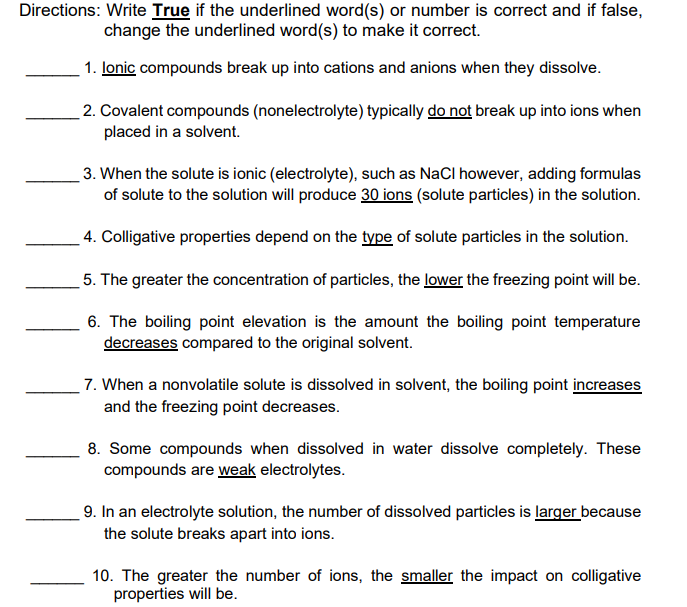Directions: Write True if the underlined word(s) or number is correct and if false, change the underlined word(s) to make it correct. 1. lonic compounds break up into cations and anions when they dissolve. 2. Covalent compounds (nonelectrolyte) typically do not break up into ions when placed in a solvent. 3. When the solute is ionic (electrolyte), such as NaCl however, adding formulas of solute to the solution will produce 30 ions (solute particles) in the solution. 4. Colligative properties depend on the type of solute particles in the solution. 5. The greater the concentration of particles, the lower the freezing point will be. 6. The boiling point elevation is the amount the boiling point temperature decreases compared to the original solvent. 7. When a nonvolatile solute is dissolved in solvent, the boiling point increases and the freezing point decreases. 8. Some compounds when dissolved in water dissolve completely. These compounds are weak electrolytes. _ 9. In an electrolyte solution, the number of dissolved particles is larger because the solute breaks apart into ions. 10. The greater the number of ions, the smaller the impact on colligative properties will be.
Directions: Write True if the underlined word(s) or number is correct and if false, change the underlined word(s) to make it correct. 1. lonic compounds break up into cations and anions when they dissolve. 2. Covalent compounds (nonelectrolyte) typically do not break up into ions when placed in a solvent. 3. When the solute is ionic (electrolyte), such as NaCl however, adding formulas of solute to the solution will produce 30 ions (solute particles) in the solution. 4. Colligative properties depend on the type of solute particles in the solution. 5. The greater the concentration of particles, the lower the freezing point will be. 6. The boiling point elevation is the amount the boiling point temperature decreases compared to the original solvent. 7. When a nonvolatile solute is dissolved in solvent, the boiling point increases and the freezing point decreases. 8. Some compounds when dissolved in water dissolve completely. These compounds are weak electrolytes. _ 9. In an electrolyte solution, the number of dissolved particles is larger because the solute breaks apart into ions. 10. The greater the number of ions, the smaller the impact on colligative properties will be.
Introductory Chemistry: A Foundation
9th Edition
ISBN:9781337399425
Author:Steven S. Zumdahl, Donald J. DeCoste
Publisher:Steven S. Zumdahl, Donald J. DeCoste
Chapter15: Solutions
Section: Chapter Questions
Problem 96AP
Related questions
Question

Transcribed Image Text:Directions: Write True if the underlined word(s) or number is correct and if false,
change the underlined word(s) to make it correct.
1. lonic compounds break up into cations and anions when they dissolve.
2. Covalent compounds (nonelectrolyte) typically do not break up into ions when
placed in a solvent.
3. When the solute is ionic (electrolyte), such as NaCl however, adding formulas
of solute to the solution will produce 30 ions (solute particles) in the solution.
4. Colligative properties depend on the type of solute particles in the solution.
5. The greater the concentration of particles, the lower the freezing point will be.
6. The boiling point elevation is the amount the boiling point temperature
decreases compared to the original solvent.
7. When a nonvolatile solute is dissolved in solvent, the boiling point increases
and the freezing point decreases.
8. Some compounds when dissolved in water dissolve completely. These
compounds are weak electrolytes.
9. In an electrolyte solution, the number of dissolved particles is larger because
the solute breaks apart into ions.
10. The greater the number of ions, the smaller the impact on colligative
properties will be.
Expert Solution
This question has been solved!
Explore an expertly crafted, step-by-step solution for a thorough understanding of key concepts.
This is a popular solution!
Trending now
This is a popular solution!
Step by step
Solved in 4 steps

Knowledge Booster
Learn more about
Need a deep-dive on the concept behind this application? Look no further. Learn more about this topic, chemistry and related others by exploring similar questions and additional content below.Recommended textbooks for you

Introductory Chemistry: A Foundation
Chemistry
ISBN:
9781337399425
Author:
Steven S. Zumdahl, Donald J. DeCoste
Publisher:
Cengage Learning

World of Chemistry, 3rd edition
Chemistry
ISBN:
9781133109655
Author:
Steven S. Zumdahl, Susan L. Zumdahl, Donald J. DeCoste
Publisher:
Brooks / Cole / Cengage Learning

Introductory Chemistry: A Foundation
Chemistry
ISBN:
9781285199030
Author:
Steven S. Zumdahl, Donald J. DeCoste
Publisher:
Cengage Learning

Introductory Chemistry: A Foundation
Chemistry
ISBN:
9781337399425
Author:
Steven S. Zumdahl, Donald J. DeCoste
Publisher:
Cengage Learning

World of Chemistry, 3rd edition
Chemistry
ISBN:
9781133109655
Author:
Steven S. Zumdahl, Susan L. Zumdahl, Donald J. DeCoste
Publisher:
Brooks / Cole / Cengage Learning

Introductory Chemistry: A Foundation
Chemistry
ISBN:
9781285199030
Author:
Steven S. Zumdahl, Donald J. DeCoste
Publisher:
Cengage Learning

Chemistry by OpenStax (2015-05-04)
Chemistry
ISBN:
9781938168390
Author:
Klaus Theopold, Richard H Langley, Paul Flowers, William R. Robinson, Mark Blaser
Publisher:
OpenStax

Chemistry: Principles and Practice
Chemistry
ISBN:
9780534420123
Author:
Daniel L. Reger, Scott R. Goode, David W. Ball, Edward Mercer
Publisher:
Cengage Learning
